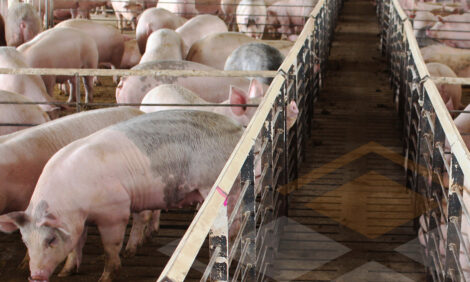



Diagnostic Techniques and Vaccines for FMD, SVD and other OIE List A Diseases
By European Commission - This article reproduces the executive summary from The Report of the Scientific Committee on Animal Health and Animal Welfare (Adopted 24-25th April 2003) on Diagnostic Techniques and Vaccines for Foot-and-Mouth Disease, Classical Swine Fever, Avian Influenza and some other important OIE List A Diseases.Executive Summary
![]() In the last decade Europe has experienced a number of epidemics of highly contagious OIE List A animal diseases, such as foot-and-mouth disease (FMD), classical swine fever (CSF) and avian influenza (AI). The threat of infection of European livestock with such diseases has increased due to greater worldwide travel, illegal importation of meat and other animal products and the risks posed by migratory birds carrying exotic diseases.
In the last decade Europe has experienced a number of epidemics of highly contagious OIE List A animal diseases, such as foot-and-mouth disease (FMD), classical swine fever (CSF) and avian influenza (AI). The threat of infection of European livestock with such diseases has increased due to greater worldwide travel, illegal importation of meat and other animal products and the risks posed by migratory birds carrying exotic diseases.
Consequently, improvements in diagnostic techniques and vaccines for such diseases are crucial. As a consequence of disease outbreaks and the EU non-vaccination policy, many millions of animals were destroyed and the economic damage amounted to billions of euros in the outbreaks of FMD in the EU in 2001, as only one example. Apart from the economical dimensions, the mass killing of animals gives rise to animal welfare problems and considerable public concern.
Against this background, the Scientific Committee on Animal Health and Animal Welfare was requested to provide an update on available diagnostic techniques, including consideration of their rapid standardisation and validation, and methods of discriminating infected from vaccinated animals.
A general disadvantage of all laboratory-based methods is the inevitable delay caused by the time needed for samples to reach the laboratory. In order to stop the infection at the earliest possible time the availability and use of pen-side tests by the official veterinarian for a first line of diagnosis should be encouraged. Technologies for nucleic acid amplification offer great potential for the improved speed, sensitivity and specificity of viral diagnosis, including rapid detection of apparently healthy but infected animals and
great effort should focus on optimising these technologies for routine diagnosis.
Standardisation, validation and reliability of laboratory diagnostic procedures are crucial.
For this purpose, properly funded reference laboratories are essential. At the international
level, the OIE provides formal test designations for international trade. However, in the EU there is not a Community Reference Laboratory for all OIE List A diseases (there is none for FMD). Reference laboratories should specify minimum test performance for tests used in diagnosis and surveillance, develop and provide reference materials, carry out proficiency testing, perform and coordinate tasks relating to test standardisation and validation, and evaluate the use of commercial kits for OIE List A diseases.
Diagnostic manuals with detailed quality control protocols are also required. Funding constraints often impair performance of these essential tasks, i.e. there is no uniform agreement on minimum detection levels appropriate for infectious agents, whether by culture or indirect detection methods and there is no Europe-wide, official system for evaluation and approval of diagnostic veterinary tests, including commercial kits. Laboratories carrying out diagnostic tests for OIE List A diseases should operate to a third party accredited quality system.
Emergency vaccination using marker vaccines and their accompanying diagnostic tests could be a suitable tool to rapidly interrupt the chain of infection, thereby allowing an early stamping-out of the disease outbreak and avoiding collateral mass culling.
The classical FMD inactivated vaccine (containing no or low quantities of non-structural proteins) is the first choice among vaccines available for use as an emergency vaccine and can be used as a marker vaccine. However, the quality of discriminatory serological tests should be improved in order to more reliably detect infected animals in vaccinated populations. More laboratory and field studies are needed, supported by extensive virological investigations, to validate the approach of using emergency vaccination in conjunction with NSP serology.
For CSF, live vaccines based on the C-strain are much more efficacious than the newly developed E2 subunit marker vaccines, and therefore appear to be the first choice as emergency vaccine. However, C-strain vaccines do not allow the serological differentiation of infected from vaccinated pigs. Consequently, virus detection methods, such as PCR, have to be applied to demonstrate absence of infection in vaccinated populations. Research on this issue is urgently needed. The diagnostic test that accompanies the E2-subunit vaccines has some deficiencies with respect to sensitivity and specificity. Therefore more efforts should be put into the development of novel marker vaccines and companion diagnostic tests. Vaccine banks for CSF emergency vaccines should also be established.
For AI there are licensed inactivated oil emulsion vaccines only for emergency vaccination available in the EU. The experience gathered during the Italian 1999 to 2001 low pathogenic AI (LPAI) epidemics, suggests that it is possible to effectively use the heterologous vaccine approach in a differentiating infected from vaccinated animals (‘DIVA’) vaccination strategy for the control of AI in poultry. Research is required in order to determine the minimum antigen content of haemagglutinin antigen (HA) required in a vaccine for different avian species and to determine the time interval between vaccination and the development of protective immunity. Appropriate virus strains to be used in vaccines for AI should be identified and vaccine banks established, while recombinant neuraminidase proteins (N1-N9) are needed which can be used to differentiate antibodies induced by ‘vaccine’ strains from antibodies against wild type viruses.
Mathematical modelling of these highly contagious diseases is required, and in such studies the impact of various intervention strategies, such as emergency vaccination, can be evaluated. Such work will also take account of diagnostics, disease epidemiology and experimental testing of emergency vaccination. More research is needed to improve diagnostic tests, especially marker-specific tests linked to differentiating infected from vaccinated animals (‘DIVA’) vaccines, to improve their validation data and, where appropriate, improve sensitivity and/or specificity. Future ‘emergency’ vaccine developments should exploit all appropriate biotechnologies available and must also acknowledge the importance of single application, and an early onset of immunity.
New vaccination approaches and new vaccine candidates are currently adopting the potential of genetic manipulation and use of ‘vectors’, although this area of research is hampered by the concerns and constraints related to this type of approach, by limited funding and by barriers to the registration and marketing of such vaccines. In any case it will require many years and the involvement of industry for the development and commercialisation of such vaccines as well as fulfilling licensing and authorisation requirements before such vaccines are available for use in the field.
To read the complete report of the Scientific Committee on Animal Heath and Animal Welfare titled:
Diagnostic Techniques and Vaccines for Foot-and-Mouth Disease, Classical Swine Fever, Avian Influenza and some other important OIE List A Diseases
just click the link.
Source: Council of Europe, European Union - April 2003






